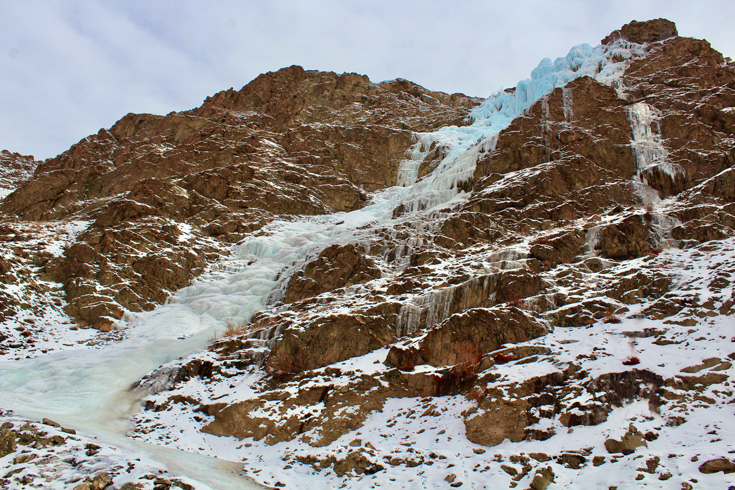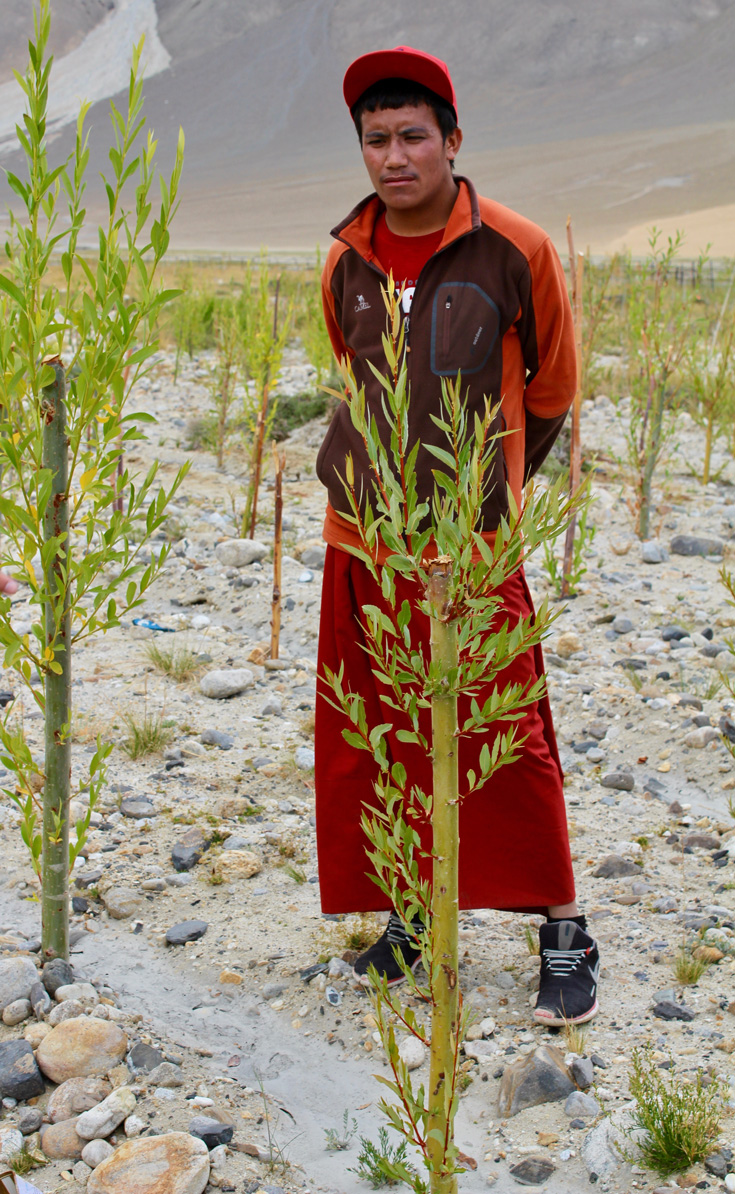Buddhist monks in the Himalayas are taking action against climate change, inspired by their devotion to His Holiness Kyabgön Chetsang Rinpoche. Eben Yonnetti reports.
Villagers dig holes to plant willows as part of a Go Green, Go Organic initiative, 2018. Photo with permission by Sierra Gladfelter.
On the morning of Earth Day, April 2018, several thousand people converged on the central plain of the tiny village of Yerat high up in the Indian Himalayas to plant trees. Carrying an assortment of shovels, picks, kitchen spoons, and even make-shift butter tin spades, the assembled villagers, monastics, school children, members of the Indian armed forces, and other volunteers diligently and cheerfully set about digging holes and trenches to plant several thousand native trees, as well as sea buckthorn and red-branched onbu bushes. Divided into teams by village and affiliation, in just a few short hours the entire plantation site was filled with over three thousand saplings. Participants then packed up their assorted tools and moved on to the day’s second plantation site, downstream in the nearby village of Chillam. When I asked volunteers during my research on Buddhism and the environment in Ladakh why they chose to participate in the large-scale plantation events that day as well as in previous years, the reply was unequivocal: they were inspired to participate because of their devotion to His Holiness Kyabgön Chetsang Rinpoche and his vision for a more verdant and organic Ladakh.
In ecologically sensitive areas like Ladakh, the disastrous fallout of the world’s climate crisis is not so much a dire future prediction as a current reality.
Born in 1946 in Lhasa, Chetsang Rinpoche was recognized as the seventh reincarnation of the Chetsang lineage, one of two lineages that jointly head the Drikung Kagyü school of Tibetan Buddhism. As he describes in his autobiography, Chetsang Rinpoche’s interest in environmental protection began during his childhood and young adult life while working on communal farms in Tibet during the Cultural Revolution. In more recent years, besides being a staunch advocate of vegetarianism, organic farming, and environmental and cultural protection, Chetsang Rinpoche has become an increasingly vocal promoter of sustainable development and the need to address the localized impacts of climate change. He stresses the need for everyone to take whatever small steps they are able to in order to help combat climate change globally, as well as to be proactive in adapting to its anticipated effects in their local settings. He says that religious leaders like himself can no longer just stay in the monastery and pray for a better world, but rather must also “go out into society and help people according to the needs of the twenty-first century.” Although Chetsang Rinpoche’s monastic and lay students in the Indian alpine desert region of Ladakh are neither numerous nor affluent, a large number have followed his call and become very active in local efforts to protect their environment and adapt to the localized impacts of the climate crisis.

Artificial icefall glacier in Kukshow, 2017. Photo by Eben Yonnetti.
In ecologically sensitive areas like Ladakh, the disastrous fallout of the world’s climate crisis is not so much a dire future prediction as a current reality. The region has lost more than twenty percent of its permanent ice reserves. Glaciers that middle-aged Ladkhis once climbed upon in their youth have disappeared, and snowfall that once blanketed villages throughout the winter is a rarity today. Considering that nearly all Ladakhi villages depend solely on glacial and snowmelt for their water, the rising temperatures and dwindling snowfall of recent years does not bode well for the region’s future water needs. Moreover, what precipitation does occur in Ladakh is increasingly being received in destructive and intense cloudbursts that the arid landscape cannot absorb.
Responding to already limited water resources and planning for further reductions as the impacts of the climate crisis further intensify in the region, Chetsang Rinpoche along with monastic and lay leaders in Ladakh have begun a number of projects to adapt. In the north-eastern region of Ladakh, residents and monastics have supported the work of the organization Go Green, Go Organic. Led by a team of monastic and lay village representatives, Go Green, Go Organic has supported the planting of several hundred thousand native species of trees and shrubs in low-lying areas and along streambanks in Ladakh. This effort began with the first large-scale tree plantation in the village of Shayok in 2014. In addition to providing fodder for villagers’ animals and reducing the carbon costs involved with importing lumber to the region, the Go Green, Go Organic leadership also hopes that these high-altitude afforestation projects will slow run-off, retain water locally, and transform villages into carbon-negative communities. Go Green, Go Organic has also worked to support the adoption of one hundred percent organic agriculture in villages across Ladakh.

A village monk and member of Go Green, Go Organic stands surrounded by native willows planted in 2015. Photo with permission by Sierra Gladfelter, 2017.
In Ladakh’s Sham region, Chetsang Rinpoche and monastic leaders have partnered with both Buddhist and Muslim villagers to construct various ice reservoir projects. Although constructed in different forms, all of these projects essentially work on the same principle of diverting water from springs and streams into catchments through the winter season when there is no agriculture and limited domestic use of water resources locally. In doing so, these structures prevent water from running downstream and store it in the form of ice above a village, thereby bolstering springtime water resources critical to the farming livelihoods of many Ladakhis. In 2016, the first artificial icefall glacier was completed in Kukshow village. Over the course of the winter it formed a three-hundred-foot-tall ice-waterfall that flowed down a shaded cliff-face above the village and provided additional water for farmers into the early summer. Since then, the monastic leaders have organized and assisted with the installation of similar artificial icefall glaciers in a number of other villages.
The monastics spearheading the artificial icefall glaciers do not view organizing these projects as separate from their religious practice so much as an extension of it. As one monastic leader describes, while traditionally monastic practitioners would spend their time performing rituals or engaged in meditation, with the myriad issues facing the world today, it is necessary for monks and Buddhist practitioners to do more than meditate or recite mantras. In his words, “Today, we are monks in action!”
Thank you for reading Lion’s Roar. Now can we ask for your help?
Lion’s Roar is a nonprofit. Our mission is to share the wisdom of the Buddha’s teachings—to inspire, comfort, support, and enlighten readers around the world. Our aspiration is to keep LionsRoar.com available to everyone, providing a supportive, inspiring Buddhist community that anyone can access, from curious beginners to committed meditators. Do you share our aspiration? We can’t do this without your help.
Lion’s Roar reaches more readers like you than ever before. Unfortunately, advertising and other revenues are falling for print and online media. We know we have something deeply precious to share with the world, and we want to continue this important work. Can you help support our efforts now?
Lion’s Roar is independent, unbiased, not-for-profit, and supported by readers like you. Please donate today and help the lion’s roar echo for readers around the world.